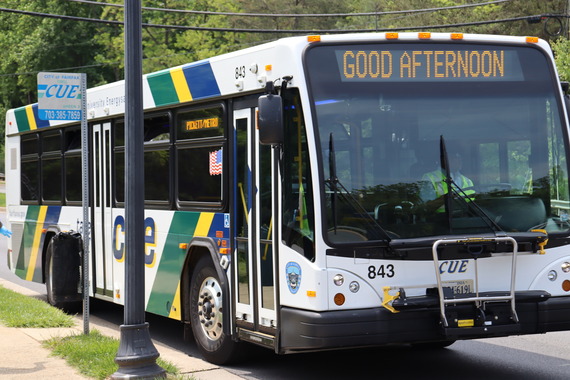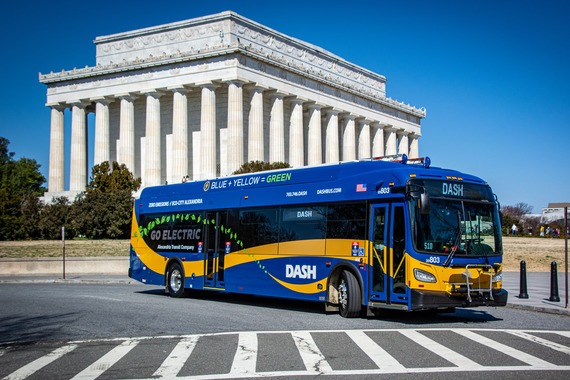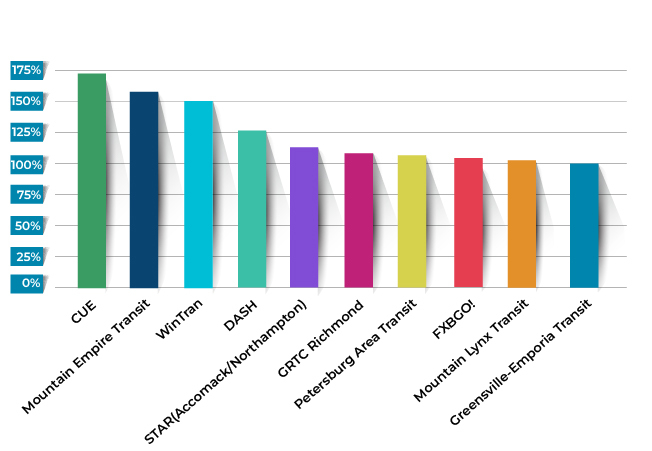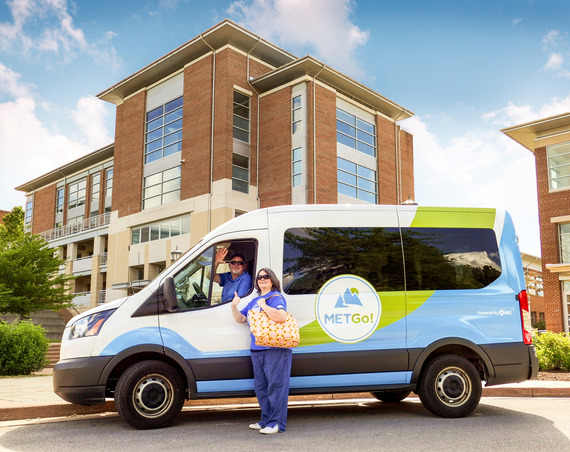|
Welcome to the Department of Rail and Public Transportation’s second-ever Data Story thank you for signing up! This monthly series offer engaging data-driven narratives on Virginia’s rail and public transportation using the performance data DRPT collects. These data, out of context, can often be hard to digest. Data Stories aims to find the narrative from the data DRPT collects. This month, Data Stories reveals the transit agencies that have the highest post-pandemic ridership recovery. |
|
Transit Ridership Recovery

|
|
More than four years ago, public transit ridership across Virginia hit an all-time low due to the covid-19 pandemic. April 2020 saw only 1.6 million trips using public transit in Virginia, down from 4.8 million in February of that same year (not including WMATA/Metro or the Virginia Railway Express). In March 2024, Virginia’s public transit agencies recorded nearly 4.3 million unlinked passenger trips bringing Virginia to 90% of pre-pandemic ridership.
Many transit agencies are still steadily regaining ridership and approaching their pre-pandemic ridership. However, ten transit agencies across Virginia have not only met pre-pandemic ridership but set new records – in some instances reaching more than 150% pre-pandemic ridership. This month’s Data Story will explore DRPT’s ridership performance data and highlight the ten transit agencies setting new records.
Notes & Definitions
Before getting into the data, a few notes: First, defining pre-pandemic and post-pandemic ridership. This data story compares December 2019 through February 2020 as the pre-pandemic quarter and the baseline for recovery and December 2023 through February 2024 as the post-pandemic quarter. These months were selected to not include the mid-month ridership drop-off in March 2020 in the baseline. It also includes multiple months of data to represent ridership more accurately, as ridership fluctuates over certain months. Disadvantages of this comparison are that December, January, and February tend to be among the slower months for transit usage (due to holidays, college students being home for break, and February being a shorter month) and that one transit agency – the Pony Express in Chincoteague – is excluded from comparison as it only operates in the peak tourist season from May to October.
|
|
|
Recovery
Of the 40 public transit agencies (not including WMATA and VRE) that provide public transit service in Virginia, ten have exceeded their pre-pandemic ridership at the time of writing. These agencies vary greatly, some serving rural localities and operating primarily microtransit services, others serving major metropolitan areas with rapid fixed-route transit. These agencies are driving Virginia’s statewide transit recovery and demonstrating how transit agencies can not only survive but thrive in a post-pandemic world.
CUE (The City-University Energysaver, which operates in the City of Fairfax and at George Mason University) leads the entire state in the percentage of current ridership compared to pre-pandemic levels with its ridership at 167% of pre-pandemic levels. CUE transported over 230,000 people from December 2023 to February 2024, compared to 140,000 during the corresponding pre-pandemic quarter from December 2019 to February 2020.
CUE operates two services – the fixed route Green and Gold buses – which connect George Mason University to the Vienna/Fairfax Metro Station and points between. Additionally, CUE does not charge fares thanks to the state-funded Transit Ridership Incentive Program and local contributions from the City of Fairfax.
While CUE leads Virginia in percentage increase over pre-pandemic levels, it is not the leader in absolute ridership increase. Nearby DASH, officially the Alexandria Transit Company, transported 345,000 more people from December 2023 to February 2024 than it transported from December 2019 to February 2020. The 1.2 million people transported by DASH from December 2023 to February 2024 was 140% of pre-pandemic levels – this was the fourth largest percentage increase over pre-pandemic ridership of Virginia’s transit agencies.
 DASH operates more than ten fixed-route bus services across Alexandria and is developing two Bus-Rapid Transit services along Duke Street and Alexandria’s west end. Just like Fairfax City’s CUE, DASH does not collect fares.
The second highest proportional increase in transit ridership is Mountain Empire Transit, the first-ever rideshare service in the Counties of Lee, Scott, and Wise, and the City of Norton in Southwest Virginia. Mountain Empire Transit’s ridership is 155% pre-pandemic levels, providing over 35,500 trips from December 2023 to February 2024, 12,700 more than during the same period in 2019-2020. Mountain Empire Transit, which also operates the Microtransit service METGo!, operates Monday through Friday and provides curb-to-curb service for anyone (regardless of age) in its service area.
All ten transit agencies with higher ridership compared to pre-pandemic levels are shown in the graph below:

|
|
|
The table below shows all Virginia transit agencies and their absolute and proportionate ridership recovery:
|
Transit Agency
|
Dec. 2019-Feb. 2020 Ridership
|
Dec. 2023-Feb. 2024 Ridership
|
Increase
|
Percentage of pre-pandemic ridership
|
|
CUE
|
140,165
|
234,627
|
94,462
|
167%
|
|
Mountain Empire Transit
|
22,932
|
35,631
|
12,699
|
155%
|
|
WinTran
|
30,013
|
45,073
|
15,060
|
150%
|
|
DASH
|
870,591
|
1,216,016
|
345,425
|
140%
|
|
STAR (Accomack/Northampton)
|
19,448
|
24,560
|
5,112
|
126%
|
|
GRTC Richmond
|
2,241,985
|
2,567,438
|
325,453
|
115%
|
|
Petersburg Area Transit
|
98,900
|
109,634
|
10,734
|
111%
|
|
FXBGO!
|
67,147
|
74,083
|
6,936
|
110%
|
|
Mountain Lynx Transit
|
36,029
|
39,350
|
3,321
|
109%
|
|
Greensville-Emporia Transit
|
2,733
|
2,762
|
29
|
101%
|
|
|

The ten transit agencies that are exceeding their pre-pandemic ridership represent a broad range of services, sizes, and geographies. While services like GRTC and DASH serve major urbanized areas with frequent fixed-route transit, METGo! and Mountain Lynx Transit serve smaller cities and towns and large rural areas.
Ten agencies so far have exceeded pre-pandemic ridership, however, many more are not far off. Fairfax Connector in Fairfax County and Bay Transit (operated by Bay Aging) are examples of transit agencies that may soon meet or exceed pre-pandemic ridership levels. Be sure to check DRPT’s Transit Performance Measures on the data portal to check their progress!
|
|
What to Know More?
DRPT regularly updates its Transit Performance Measures on our Open Data Portal. Transit ridership is updated quarterly for all 40 transit agencies in Virginia. Tracking ridership is an important metric – not just to track the usage of public transit, but also because it is a factor used to determine the state funding each transit agency may receive from Virginia.
|
|
 |
|
|
DRPT’s mission is to connect and improve the quality of life for all Virginians with innovative transportation solutions. The SYIP turns that mission into action, by funding rail and public transportation priorities. With funding from the SYIP, transit agencies across Virginia provide over 10 million trips per month on buses, light rails, and subways. Freight rail programs divert around 14 million trucks from Virginia’s roads and attract hundreds of new jobs. Having trouble viewing this email? View it as a Web page. |
|
|
|
|